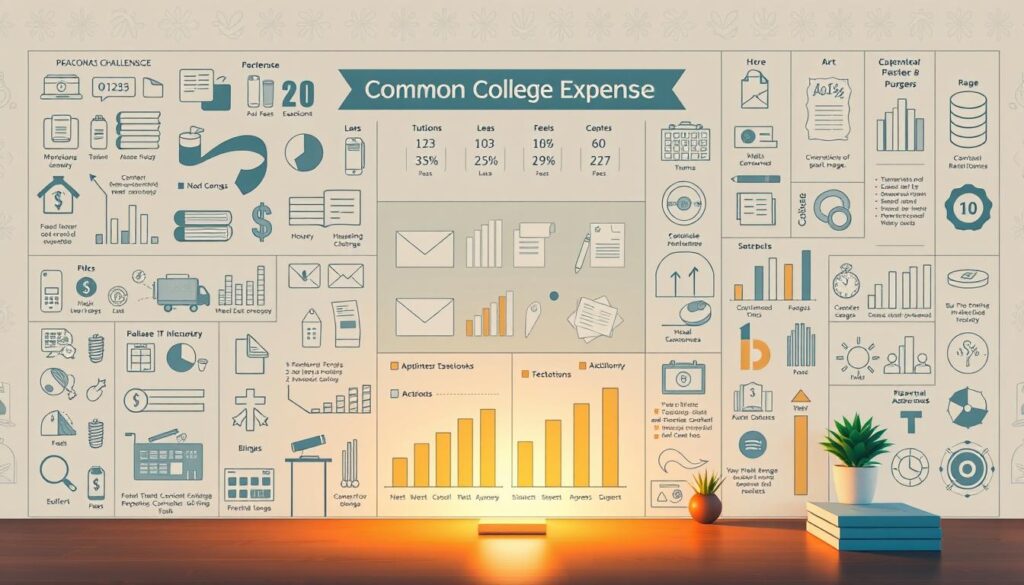Budgeting Tips for College Students: A Practical Guide
Did you know the average grad leaves school with $31,000 in combined loans and credit card debt? That’s more than many entry-level salaries—and it’s why learning to manage your cash early matters more than ever.
Over 20% of undergrads admit they’re unprepared to handle their finances. But here’s the good news: smart money habits aren’t about penny-pinching. They’re about owning your choices—whether you’re splitting rent, buying textbooks, or saving for spring break.
Think of this guide as your financial GPS. We’ll show you how to stretch every dollar, from meal plans to part-time gigs. You’ll learn to track expenses like a pro, prioritize needs over wants, and still have cash for late-night pizza runs.
Key Takeaways
- Graduates face an average debt of $31,000 without proper planning
- Building a financial foundation reduces stress during school years
- Tracking monthly spending helps avoid overspending traps
- Practical strategies work for loans, jobs, or family support
- Small changes today create long-term stability after graduation
Understanding College Budgeting Essentials

Nearly 60% of undergrads report unexpected costs derailing their spending plans. To avoid this pitfall, start by mapping out your biggest financial commitments. Let’s break down where your money goes—and where it should go.
Navigating Tuition, Housing, and Other Expenses
Tuition often eats up the largest chunk of funds. Public universities charge $10,740 annually on average for in-state students—before adding housing. Dorms might seem convenient, but off-campus apartments can save $2,000+ yearly if you split rent wisely.
Meal plans cost $4,500 per academic year versus $3,990 for self-prepared meals. That’s $500 you could redirect toward books or emergencies. Speaking of textbooks: first-year learners spend $1,212 typically. Swap new editions for rentals or digital versions to slash this by half.
Assessing Your Income and Financial Aid
Your funding mix determines what you can afford. List every source:
- Family contributions
- Work-study paychecks
- Scholarships/grants
If your financial aid package exceeds tuition costs, you’ll get a refund. Treat this like a lifeline—not free cash. Allocate it to essential expenses like lab fees or winter housing. Seasonal jobs? Plan budgets by semester since summer earnings might not cover fall needs.
Budgeting Tips for College Students

Every dollar decision in school shapes your financial future. Let’s explore three game-changing strategies that keep your accounts healthy without missing out on campus life.
Identifying Must-Have Expenses vs. Wants
Needs keep you alive and enrolled: rent, groceries, textbooks. Wants make life sweeter: concert tickets, upgraded dorm decor, daily lattes. Financial expert Rachel Cruze puts it bluntly: “If it won’t matter in 24 hours, it’s probably a want.”
Try this test: Before buying, ask if you’d still want it after a week. That $40 wireless speaker? Cool today, forgotten by Friday. A graphing calculator? Essential for finals week.
Leveraging Budgeting Apps and Tools
Mint automatically sorts your Starbucks runs from textbook purchases. Microsoft’s student-specific Excel template shows where your money goes each month. Prefer free options? Google Sheets works on any phone or computer.
Set alerts when you hit 75% of your dining-out allowance. These tools turn vague resolutions into clear numbers: “You’ve spent $127 on snacks this month” beats guessing.
Minimizing Reliance on Credit and Student Loans
Only borrow what covers tuition and essential supplies—never spring break trips. If using a credit card to build credit:
- Pick one with no annual fee
- Set up autopay for full balances
- Use it solely for gas or groceries
Remember: Loans taken today become tomorrow’s paycheck deductions. That $300 extra borrowed for a new phone? With interest, it becomes $375 you’ll repay post-graduation.
Creating a Sustainable College Budget

Financial control begins with one simple move: splitting your money into fixed and variable categories. Think of it like organizing your closet—separate the essentials from the extras so you always know what’s available.
Categorizing Fixed and Variable Expenses
Fixed costs stay the same each month—rent, tuition payments, phone bills. These get priority. Open a dedicated bank account for them so the cash stays untouched. Variable expenses? Groceries, weekend plans, gas. These go into a separate account with flexible spending limits.
The 50/30/20 rule works like this: 50% for needs, 30% for wants, 20% for savings. But college income isn’t always steady. Adjust the ratios if your work-study checks vary. “Treat savings like a required course fee,” advises financial planner Mark Reyes. Skip one month, and you’ll struggle to catch up.”
Setting Up a Savings Plan and Emergency Fund
Start your emergency fund with $10 weekly. That’s lunch money—but over a semester, it becomes $120 for unexpected car repairs or urgent pharmacy runs. The Consumer Financial Protection Bureau suggests writing down your target amount and deadline. Example: $500 by finals week.
Automate monthly transfers from your checking to savings account. Apps like Qapital can round up coffee purchases and stash the change. Remember: A college student’s safety net doesn’t need to be huge—just reliable.
Smart Ways to Save Money in College
![]()
Your student ID holds more power than you think – 72% of learners miss out on available discounts annually. Let’s unlock hidden savings and transform everyday spending habits without sacrificing campus experiences.
Taking Advantage of Student Discounts
Major retailers like Apple and Adobe offer 10-25% off for verified students. Apps like Student Beans and UNiDAYS serve as your digital discount hub, connecting you to deals from HP laptops to Dr. Martens boots. Always ask “Do you offer student discounts?” at restaurants, museums, and software stores – you’ll be surprised how often the answer’s yes.
Websites like RetailMeNot compile limited-time offers across categories. Need Microsoft Office? Students get full access for $6/month instead of $20. Flying home? Many airlines provide 15% fare reductions with proper school verification.
Reducing Dining Out and Impulse Spending
That daily $5 latte adds up to $1,300 annually – enough for textbooks and supplies. Brew coffee at home using flavored syrups for café-style drinks at 1/4 the cost. Meal prep Sundays with friends turns cooking into social time while cutting food costs by 40%.
Bulk-buy snacks prevent vending machine markups. A $10 grocery store haul provides two weeks’ worth of study fuel versus $3 daily chips-and-soda runs. Carry a reusable water bottle – hydration becomes free instead of $4 bottled waters between classes.
When friends suggest pricey outings, counter with “Let’s try that new free gallery opening instead!” Most classmates appreciate budget-friendly alternatives once someone suggests them first.
Utilizing Campus Resources and Additional Money-Saving Strategies

Your campus might be hiding more free perks than you realize. From tech help to transit solutions, schools offer tools that turn financial stress into smart savings—if you know where to look.
Exploring On-Campus Financial Resources
Many schools provide free public transportation through shuttle networks and bike shares. Check your college’s website for partnerships with local bus systems—some offer unlimited rides with student IDs. This eliminates gas costs and $150/month parking fees.
Need tech help? Over 40% of universities now loan laptops for the semester. Computer labs often provide free printing credits too. One student shared: “Using campus WiFi and software saved me $900 last year.”
| Expense | Car Ownership | Campus Options |
|---|---|---|
| Monthly Cost | $385+ | $0 |
| Time Commitment | 45 mins/day | Walkable |
| Hidden Fees | Insurance, repairs | Free maintenance |
Don’t overlook emergency grants for unexpected costs. Many financial aid offices keep funds for medical bills or broken laptops. Campus food pantries and free school supplies events also help stretch your money further.
Considering Part-Time Work and Extra Income Opportunities
Work-study jobs offer triple benefits: paycheck, experience, and flexible hours. Library positions often let you study during shifts. Campus tour guides earn $12-$15/hour while building public speaking skills.
- Tutoring peers: $20/session
- Resident advisor: Free housing
- Research assistant: Career connections
Off-campus gigs like weekend babysitting or dog walking fit busy schedules. Remember: Every hour working means less time for Uber rides. One senior reported: “My campus job covered groceries and helped me graduate debt-free.”
Conclusion
Mastering your finances during school isn’t about restrictions—it’s about freedom. The choices you make with money today directly shape your post-graduation life. Whether you’re balancing part-time work or maximizing student discounts, small efforts compound over time.
Track expenses weekly to spot patterns before they drain your accounts. Use free apps to automate savings—even $20 a month builds financial muscle. Remember: Those who graduate with less debt start their careers with fewer limitations.
Your college years teach more than academics. They’re practice for real-world money management. Keep refining your system—what works freshman year might need tweaking by senior fall. Stay curious, stay flexible, and watch your financial confidence grow.
FAQ
How do I start managing my money as a student?
What if unexpected costs pop up during the semester?
Are budgeting apps worth trying?
Where can I find the best student discounts?
How can I earn extra cash without hurting my grades?
What’s the easiest way to cut food costs?
How do I save on textbooks and supplies?
Should I get a credit card for emergencies?
Can I reduce transportation expenses?
How do I handle tuition without taking big loans?

Sharon Molly is a content creator in lifestyle, fashion, and travel, delivering style-savvy advice and destination insights to inspire confident living. With a background in digital media, she combines aesthetics with practical guidance for modern women on the go.




